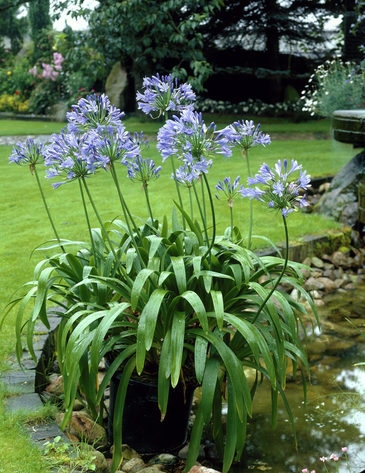How to Plant and Maintain Agapanthus in Your Yard
How to Plant and Maintain Agapanthus in Your Yard
Blog Article
Unleashing the Secret to Successful Agapanthus Farming: Advice for a Flourishing Garden
In the realm of gardening, growing agapanthus effectively needs a critical strategy that includes different aspects of plant treatment. With cautious focus to detail, one can unlock the secrets to supporting these sensational blossoms, resulting in a garden that flourishes with appeal and vibrancy. By recognizing the nuances of agapanthus farming, one can develop an atmosphere where these plants flourish and grow generously. In the adhering to conversation, we will check out necessary tips and methods that will certainly assist you towards a flourishing agapanthus garden, using insights into ideal practices, soil conditions, watering techniques, and extra.
Planting Agapanthus: Best Practices
When planting Agapanthus, proper soil preparation is crucial for guaranteeing successful growth and growth of these lovely blossoms. Agapanthus, generally referred to as Lily of the Nile or African lily, flourishes in well-draining dirt with a slightly acidic to neutral pH degree - Agapanthus. Prior to planting, it is essential to amend hefty clay dirts with raw material such as compost or peat moss to boost drainage and give crucial nutrients for the plants
To plant Agapanthus, pick an area that gets full sunshine to partial color, as this will certainly advertise healthy growth and bountiful blooming. Dig a hole two times the size of the plant's origin sphere and position the Agapanthus at the exact same deepness it was formerly growing. Delicately backfill the hole with dirt, pressing down securely to eliminate any kind of air pockets around the roots.
Water the freshly grown Agapanthus extensively and remain to keep the dirt uniformly moist, particularly during the plant's active expanding period. Agapanthus. Using a balanced plant food once a month can better sustain the plant's development and blooming. By adhering to these best practices for planting Agapanthus, you can produce a sensational screen of these exciting blossoms in your garden
Suitable Soil Issues for Agapanthus
For ideal development and blooming success of Agapanthus plants, making sure the dirt conditions are perfect is vital. Agapanthus likes soil that is rich in nutrients, so integrating a well balanced plant food during the expanding season can promote healthy growth and dynamic flowers.

Watering and Fertilizing Tips
To guarantee healthy growth and vibrant blooms, proper watering and fertilizing strategies are necessary for effective Agapanthus growing. Agapanthus plants benefit from regular watering, especially throughout the expanding period.
When it pertains to feeding Agapanthus, a balanced plant food with equivalent components nitrogen, phosphorus, and potassium can be used in the springtime to advertise healthy development and flowering. Slow-release plant foods are perfect for supplying nutrients gradually over an extended duration. Prevent over-fertilizing, as this can cause excessive vegetation growth at the expenditure of flowers.
Additionally, incorporating natural matter like compost right into the soil can boost nutrient degrees and enhance dirt framework, aiding in the total health of the Agapanthus plants. By following these watering and fertilizing suggestions, gardeners can ensure their Agapanthus plants thrive and generate magnificent screens of blossoms.
Trimming and Deadheading Techniques
Proper pruning and deadheading methods play an important function in preserving the wellness and aesthetics of Agapanthus plants, complementing the important practices of watering and fertilizing for effective growing. Trimming Agapanthus includes removing invested blossom heads, dead or yellowing fallen leaves, and general shaping of the plant to promote much better development. Deadheading, the process of getting rid of discolored flowers, not just enhances the plant's appearance but also urges more blooming.
When deadheading Agapanthus, it is suggested to trim off the blossom stem at the base utilizing sharp, tidy shears. This procedure redirects the plant's power from seed production back right into origin and vegetation growth, advertising a much healthier and much more robust plant. Regular deadheading can expand the blooming duration of Agapanthus and prevent self-seeding, which can result in overcrowding.
In regards to pruning, Agapanthus usually take advantage of a light trim after flowering to clean up the plant and encourage fresh growth. Cutting down the invested flower stems and eliminating any broken or dead vegetation assists preserve the plant's vitality and total look. However, it is crucial to avoid cutting right see here now into the crown of the plant, as this can damage its wellness.

Protecting Agapanthus From Vermins and Diseases
Carrying out effective insect and disease administration approaches is crucial to safeguarding the wellness and vigor of Agapanthus plants in growing. One usual bug that influences Agapanthus is the Agapanthus borer, a caterpillar that tunnels into the plant, creating damages to the leaves and blossoms.
In addition to pests, Agapanthus are at risk to illness such as root rot and fungal fallen leave spots. By remaining attentive and resolving parasite and condition issues quickly, gardeners can help their Agapanthus grow and flourish.
:max_bytes(150000):strip_icc()/agapanthus-growing-guide-7368912_hero-a3585e4f9ffe4b99a73c7ad8eb4ebe48.jpg)
Final Thought
In verdict, successful cultivation of agapanthus requires proper planting methods, perfect soil problems, sufficient watering and feeding, visit this site normal trimming and deadheading, and protection from illness and bugs. By adhering to these tips and tricks, garden enthusiasts can make sure a growing yard full of gorgeous agapanthus blossoms. Agapanthus. Bear in mind to maintain regular care and interest to detail to promote the health and longevity of these magnificent plants
When planting Agapanthus, proper soil prep work is important for ensuring effective growth and growth of these stunning blossoms.Water the newly grown Agapanthus thoroughly and proceed to maintain the dirt equally wet, particularly during the plant's active growing period.For optimum development and blooming success view publisher site of Agapanthus plants, making certain the soil problems are excellent is critical. When growing or hair transplanting Agapanthus, make sure the dirt is well-prepared to provide the required structure for the plants to establish themselves efficiently. One usual pest that influences Agapanthus is the Agapanthus borer, a caterpillar that tunnels right into the plant, causing damage to the flowers and fallen leaves.
Report this page